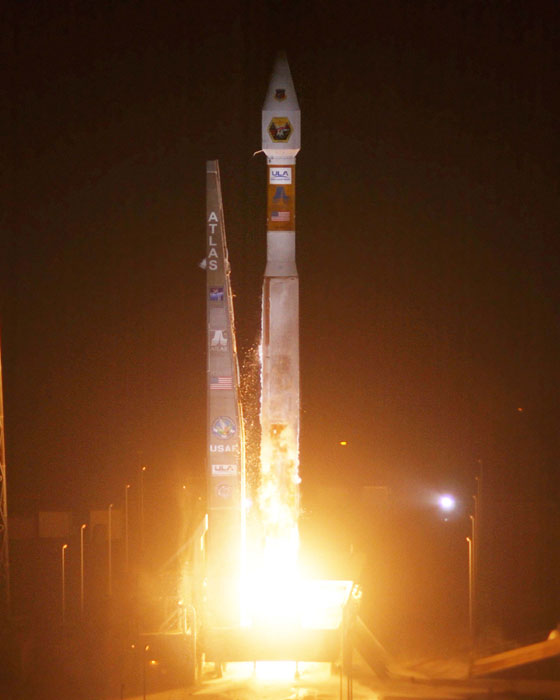NASA Considers Recycling Unmanned Rocket to Carry Astronauts

NASA has struck a deal with the United Launch Alliance, a joint rocket venture by Boeing and Lockheed Martin, to take a fresh look at upgrading an existing expendable rocket design to carry American astronauts into orbit once the space shuttle fleet retires.
"I am truly excited about the addition of [the United Launch Alliance] to NASA's Commercial Crew Development Program team," NASA chief Charles Bolden said in a statement. "Having ULA on board may speed the development of a commercial crew transportation system for the International Space Station, allowing NASA to concentrate its resources on exploring beyond low-Earth orbit."
Under this so-called unfunded Space Act Agreement, NASA and the United Launch Alliance (ULA) will provide mutual feedback and analysis to figure out how to fly a commercial crew vehicle to the International Space Station and other destinations in low-Earth orbit using ULA's Atlas 5 rocket and the risks involved with such an endeavor. [Photos: NASA's Last Shuttle Mission In Pictures]
Private spaceflight firms such as Sierra Nevada Corp. based in Centennial, Colo. and Blue Origin, based in Kent, Wash. have either selected or are strongly considering the Atlas 5 as a launch vehicle for their spacecraft, said George Sowers, ULA's vice president of business development. The Boeing Co., a major NASA contractor, is also considering the Atlas 5 rocket among other options, he added.
"The Atlas 5 appears to be the vehicle of choice for the commercial spacecraft providers," Sowers said in a news briefing today (July 18), citing the rocket's history, good performance and price as likely factors. "We didn't make that choice for them, they made that choice."
Sowers even added that the rocket could even be ready by the time the first commercial spaceships are completed – within three to four years, given adequate levels of funding for the commercial crew program.
"Middle of the decade is a bit soft because we want to see what the commercial industry can bring forward and get to completion," Ed Mango, manager of NASA's Commercial Crew Development program, said. "If they can get to completion quicker, that's great. If not, then that's why the middle of the decade is a little softer."
Get the Space.com Newsletter
Breaking space news, the latest updates on rocket launches, skywatching events and more!
The risk and hazard analysis work with NASA, which should be completed within six to nine months, will include maturing ULA's efforts that began during the first round of the agency's Commercial Crew Development program, as well as understanding what modifications will need to be made before a crew capsule can be placed on top of the rocket.
"We're taking steps to continuing on with being leaders of human spaceflight," Mango said. "It's a good day for commercial crew programs, good day for ULA, and good day for Americans."
This work will help ULA's efforts toward certifying the workhorse Atlas V rocket for human spaceflight. One critical step in that certification process will be the development of an Emergency Detection System (EDS), which will monitor critical launch vehicle and spacecraft systems and issue warning or abort commands to the onboard crew during their flight.
In 2010, ULA was awarded $6.7 million by NASA on top of its own $1.3 million investment to develop a test version of the EDS.
ULA's Atlas 5 family of rockets debuted in August 2002 and have primarily provided launch services for U.S. Department of Defense payloads. The Atlas 5 rocket boasts 26 launches with a 100 percent mission success rate.
NASA is currently flying the final mission of its 30-year space shuttle program. Once the orbiter fleet is grounded for good, the agency will rely on commercial providers to ferry supplies, and eventually astronauts, to the International Space Station and other destinations in low-Earth orbit. The agency is retiring its shuttle program to focus on exploration missions deeper in space, to destinations like an asteroid or Mars.
You can follow SPACE.com staff writer Denise Chow on Twitter @denisechow. Follow SPACE.com for the latest in space science and exploration news on Twitter @Spacedotcom and on Facebook.
Join our Space Forums to keep talking space on the latest missions, night sky and more! And if you have a news tip, correction or comment, let us know at: community@space.com.

Denise Chow is a former Space.com staff writer who then worked as assistant managing editor at Live Science before moving to NBC News as a science reporter, where she focuses on general science and climate change. She spent two years with Space.com, writing about rocket launches and covering NASA's final three space shuttle missions, before joining the Live Science team in 2013. A Canadian transplant, Denise has a bachelor's degree from the University of Toronto, and a master's degree in journalism from New York University. At NBC News, Denise covers general science and climate change.









